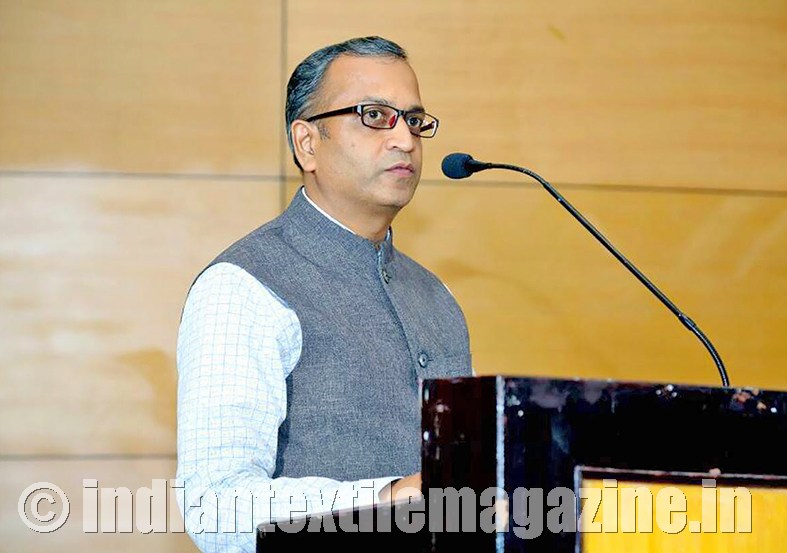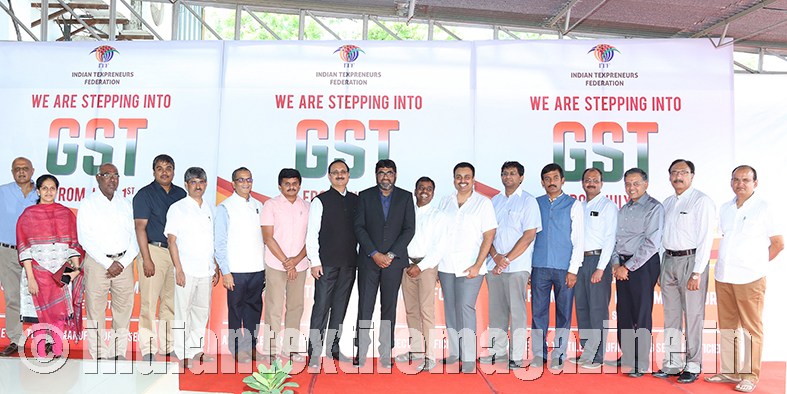The Indian Texpreneurs Federation (ITF) has been in the news recently for all the right reasons. The association has been working with various stakeholders in the textile industry, coming up with initiatives such as in the field of energy savings, buying cotton for its members, helping mills improve their credit ratings and creating market intelligence platforms for members to share datas.

ITF’s path-breaking work has seen it gradually grow its membership base across Tamil Nadu. It is also in constant touch with policy makers, both at the Central and State levels, representing the textile industry.
ITF is also unique in the sense that even though all its members are competitors in the market, they have all come together for the betterment of the textile industry. The ITF members get to build their industry exposure. They also get to regularly interact with various specialists, from time to time, and get access to world-class technical information and expertise.
The Textile Magazine caught up with Mr. Prabhu Dhamodharan, Convenor, ITF, recently, who spoke in detail about the various initiatives of the association and gave his views on the present scenario in the textile industry and its immediate future, and the future of ITF, among others.
Here are the edited excerpts:
Beginning the interaction with a reflection of the trends in the textile industry in 2017-18, Mr. Prabhu felt that it could be neither termed the worst year nor the best year. “You can say that the things were okay. Manageable,” he said while adding, “so far as challenges go, exports has been definitely challenging for Indian companies. The only thing positive to happen was the good showing of the domestic market, particularly after the roll-out of the GST regime. Organized retail and branded segments are growing. Those who are making quality products can expand in a big way in the domestic market. In our view, at least 10-12% growth will be there in the domestic market.”
He added: “We have advised our members to focus on the domestic market, because people are spending more on clothing, the per capita income is rising, so too the younger population is rising. The younger population has aspirations. South India is a big consumption market”.
He felt the difference in GST between cotton and man-made fiber is affecting the industry. Elaborating on the issue, he said: “GST is a good initiative. There is no doubt about it. Now the entire cotton manufacturing value chain is under GST. For cotton GST is 5%, for man-made fiber it is 18%. We need a uniform taxation structure for all raw materials. International buyers are asking for blends. They don’t want pure cotton. This is hurting us. Even the Chief Economic Adviser advocated that we need a fiber-neutral GST rate. This way we can also grow our exports too.”
ITF’s growing influence
Elaborating on the role being played by ITF for the progress of the textile industry, Mr. Prabhu said: “ITF is definitely growing. Our idea of ITF is trying to increase the competitiveness to face the global challenges. Even though all our members are competitors with similar products, we are working together as a team to achieve manufacturing excellence. We are always searching for ideas, sharing ideas on how we can improve our competitiveness, because at the end of the day, we have to be the lowest cost producer, offering the highest quality product. Individually we can only do limited things. As a group of more than 500 like-minded members, we can do much more. In fact, we are doing extremely well.”
ITF has been clocking good growth rates. From 450 members earlier, it now has 510 members. However, Mr. Prabhu pointed out that they are very careful with inducting new members. “Like-mindedness is the key to join us as a member. We want members to share ideas. To participate actively in the association’s initiatives, we want our members to be active.”
Need to explore other markets
ITF has been regularly in touch with the Government departments trying to lay stress on certain policy decisions such as FTA. Going into details, Mr. Prabhu observed: “Without FTA with more countries, Indian textile exports cannot grow. So, from time to time, we have been representing to the Government. For e.g., Russia imports around Rs. 50,823 crores worth of textiles annually, of which India’s share is only Rs. 1,822 crores. So, we have submitted a paper to the Government, explaining why India should sign an FTA with Eurasia.”
Giving another example, Mr. Prabhu pointed to Brazil which imported Rs. 18,500 crores worth of textiles last year, out of which India’s share was just around Rs. 1,100 crores. He added that Russia and Brazil, are part of BRICS and therefore there is a good opportunity waiting there.
“At the end of the day we cannot be dependent only on the US and EU markets. We need to expand. We have in fact hired the services of a top foreign trade expert firm in Mumbai in order to find out what should be done for India to capture global textile markets and what needs to be done in terms of FTA. We are going to submit this study to the Government soon,” he added.
Expo – a must
Another thing that ITF is passionate about is to conduct an expo. According to him with the help of Indian embassies, we can easily invite around 30 countries. He said: “All buyers and brands they will come if the Government invites them. In one single place we can display all the textile products so that there is better connect. If we conduct such an event for 3-4 years, naturally that particularly month would stay in everyone’s memory. We can conduct the expo in Tamil Nadu, which has such an ideal ecosystem. A small SME manufacturer cannot visit all the countries. They cannot explore new markets. It is the Government that should enable these kinds of connect, so that the trade grows,” he elaborated.
Help to members
ITF is also appointing experts to reduce manufacturing costs. Explaining the point, Mr. Prabhu stated: “We have a policy – ‘how can we reduce energy costs’. We have lots of mechanisms to do that. We have been setting new benchmarks in a few mills. For instance, a mill with a spindle capacity of 20,000 can save Rs. 1 crore in energy costs annually. We have achieved this in a few mills. This can be replicated anywhere. Similarly, we have appointed a consultant to improve our credit ratings. He can negotiate with bankers for better interest rates. We are also sharing the best practices”.
ITF is also providing market intelligence on yarns to its members. Speaking about the process in detail, Mr. Prabhu said: “We are doing market surveys. We are circulating the information internally among our members. This way they get to know the trends in the market. A mill in Rajapalayam and a mill in Udumalpet, even though they make the same product, there is no connect. If a buyer calls and tells them that the market is down, they panic. Now due to the market intelligence we provide, they need not panic. They now know the trends in the market.”
The ITF office-bearers are constantly in touch with top Ministers. Recently they met the Union Commerce Minister, Mr. Suresh Prabhu, and discussed the FTA issue. Bangladesh and a couple of other issues were on the agenda.
Mr. Prabhu, however, did not agree to the perception that the Indian textile industry has got too many associations. His take in the issue is that there are several segments in the industry and hence the high number of associations.
Going further into details, he said: “We need to look at the ground reality. Someone sitting somewhere else will not know the ground reality. So, there is no harm in regional associations representing the industry. The only thing is that we should not hurt the other segments of the industry. We have to take a balanced and long-term view. Maybe we should all arrive at a common minimum program. We can also take each other’s help from time to time.”
Huge growth potential
The Convenor of ITF feels that the Indian market has huge growth potential and there are certain things that need to be done on an urgent basis in order to tap this potential.
He further observed: “We need to focus on having bigger-sized factories. Bangladesh has them. That is why they are able to grow in a cost-effective manner. It is not possible in Tamil Nadu. Wherever there is manpower we can set up such units. They will be more efficient . We can bring in automation and can make a variety of products. We can do greater volumes also.”
Oversupply in spinning
Mr. Prabhu felt that there is oversupply in the spinning segment. “There are very few greenfield projects. People are finding it difficult to repay debts. It is better to focus on sectors like apparel or woven, or even air jet weaving, because India lags behind in weaving capacity. In future we cannot get manpower of running power looms, so we need upgradation. Already many weavers are investing in air jet weaving. Everyone should move up the value chain instead of just making the yarn. Everyone should venture into weaving, apparel, branding and e-commerce.”
Throwing further light on the e-commerce potential he said: “Companies like Myntra and Flipkart are touching $2 billion in apparel. Why can’t entrepreneurs in Coimbatore, Tirupur and Karur utilize the e-commerce boom. If you want to set up shops everywhere you need huge money. Now, with e-commerce, with a simple design studio and employing youngsters who understand fashion, small companies can grow in a big way.”
Purchasing cotton
Keeping in line with this approach of innovation and finding new opportunities for its members, ITF has created a cotton team too. Almost 32 mills are now buying cotton from the association. “We have already purchased 33 lakh bales in this cotton year. We intend purchasing 5 lakh bales. With collective purchase we are getting the right intelligence. We are not allowing members to go by speculation. We are able to partner with ginners to offer quality cotton with less contamination. About 60-65% of our sales value is cotton. So, we created this team to help our members. Next year the number of members in the ITF cotton team will go up,” he remarked.
On a parting note Mr. Prabhu, while explaining the other initiatives of ITF, said: “With yarn too we want to make a value-added product. We are working on how to align with the customers. How can we achieve cost leadership? How can we be the lowest cost manufacturer? We are working on all these concepts and ensuring that we are protected in terms of our margins and keep growing.”
By M.K. Prabhakar & Mohan Raj
